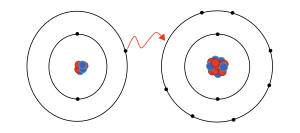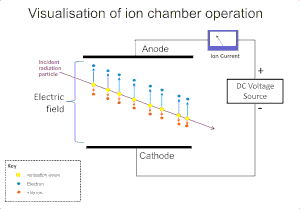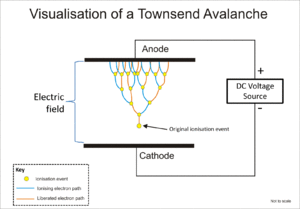Ion

Anion(/ˈaɪ.ɒn,-ən/)[1]is anatomormoleculewith a netelectrical charge.The charge of anelectronis considered to be negative by convention and this charge is equal and opposite to the charge of aproton,which is considered to be positive by convention. The net charge of an ion is not zero because its total number of electrons is unequal to its total number of protons.
Acationis a positively charged ion with fewer electrons than protons[2]while ananionis a negatively charged ion with more electrons than protons.[3]Opposite electric charges are pulled towards one another byelectrostatic force,so cations and anions attract each other and readily formionic compounds.
Ions consisting of only a single atom are termed atomic ormonatomic ions,while two or more atoms form molecular ions orpolyatomic ions.In the case of physical ionization in a fluid (gas or liquid), "ion pairs" are created by spontaneous molecule collisions, where each generated pair consists of a free electron and a positive ion.[4]Ions are also created by chemical interactions, such as thedissolutionof asaltin liquids, or by other means, such as passing adirect currentthrough a conducting solution, dissolving ananodeviaionization.
History of discovery
The wordionwas coined from neuter present participle of Greek ἰέναι (ienai), meaning "to go". A cation is something that moves down (Greek:κάτω,kato,meaning "down" ) and an anion is something that moves up (Greek:ἄνω,ano,meaning "up" ). They are so called because ions move toward the electrode of opposite charge. This term was introduced (after a suggestion by the EnglishpolymathWilliam Whewell)[5]by English physicist and chemistMichael Faradayin 1834 for the then-unknown species thatgoesfrom oneelectrodeto the other through an aqueous medium.[6][7]Faraday did not know the nature of these species, but he knew that since metals dissolved into and entered a solution at one electrode and new metal came forth from a solution at the other electrode; that some kind of substance has moved through the solution in a current. This conveys matter from one place to the other. In correspondence with Faraday, Whewell also coined the wordsanodeandcathode,as well asanionandcationas ions that are attracted to the respective electrodes.[5]
Svante Arrheniusput forth, in his 1884 dissertation, the explanation of the fact that solid crystalline saltsdissociateinto paired charged particles when dissolved, for which he would win the 1903 Nobel Prize in Chemistry.[8]Arrhenius' explanation was that in forming a solution, the salt dissociates into Faraday's ions, he proposed that ions formed even in the absence of an electric current.[9][10][11]
Characteristics
Ions in their gas-like state are highly reactive and will rapidly interact with ions of opposite charge to give neutral molecules or ionic salts. Ions are also produced in the liquid or solid state when salts interact with solvents (for example, water) to producesolvated ions,which are more stable, for reasons involving a combination ofenergyandentropychanges as the ions move away from each other to interact with the liquid. These stabilized species are more commonly found in the environment at low temperatures. A common example is the ions present in seawater, which are derived from dissolved salts.
As charged objects, ions are attracted to opposite electric charges (positive to negative, and vice versa) and repelled by like charges. When they move, their trajectories can be deflected by amagnetic field.
Electrons, due to their smaller mass and thus larger space-filling properties asmatter waves,determine the size of atoms and molecules that possess any electrons at all. Thus, anions (negatively charged ions) are larger than the parent molecule or atom, as the excess electron(s) repel each other and add to the physical size of the ion, because its size is determined by itselectron cloud.Cations are smaller than the corresponding parent atom or molecule due to the smaller size of the electron cloud. One particular cation (that of hydrogen) contains no electrons, and thus consists of a single proton –much smallerthan the parent hydrogen atom.
Anions and cations

Anion (−) and cation (+) indicate the net electric charge on an ion. An ion that has more electrons than protons, giving it a net negative charge, is named an anion, and a minus indication "Anion (−)" indicates the negative charge. With a cation it is just the opposite: it has fewer electrons than protons, giving it a net positive charge, hence the indication "Cation (+)".
Since the electric charge on a proton is equal in magnitude to the charge on an electron, the net electric charge on an ion is equal to the number of protons in the ion minus the number of electrons.
Ananion(−) (/ˈænˌaɪ.ən/ANN-eye-ən,from the Greek word ἄνω (ánō), meaning "up"[12]) is an ion with more electrons than protons, giving it a net negative charge (since electrons are negatively charged and protons are positively charged).[13]
Acation(+) (/ˈkætˌaɪ.ən/KAT-eye-ən,from the Greek word κάτω (káto), meaning "down"[14]) is an ion with fewer electrons than protons, giving it a positive charge.[15]
There are additional names used for ions with multiple charges. For example, an ion with a −2 charge is known as adianionand an ion with a +2 charge is known as adication.Azwitterionis a neutral molecule with positive and negative charges at different locations within that molecule.[16]
Cations and anions are measured by theirionic radiusand they differ in relative size: "Cations are small, most of them less than 10−10m (10−8cm) in radius. But most anions are large, as is the most common Earth anion,oxygen.From this fact it is apparent that most of the space of acrystalis occupied by the anion and that the cations fit into the spaces between them. "[17]
The termsanionandcation(for ions that respectively travel to the anode and cathode during electrolysis) wereintroduced by Michael Faraday in 1834following his consultation withWilliam Whewell.
Natural occurrences
Ions are ubiquitous innatureand are responsible for diverse phenomena from the luminescence of the Sun to the existence of the Earth'sionosphere.Atoms in their ionic state may have a different color from neutral atoms, and thus light absorption by metal ions gives the color ofgemstones.In both inorganic and organic chemistry (including biochemistry), the interaction of water and ions is extremely important[citation needed];an example is energy that drives the breakdown of adenosine triphosphate (ATP).[clarification needed]
Related technology
Ions can be non-chemically prepared using variousion sources,usually involving highvoltageor temperature. These are used in a multitude of devices such asmass spectrometers,optical emission spectrometers,particle accelerators,ion implanters,andion engines.
As reactive charged particles, they are also used inair purificationby disrupting microbes, and in household items such assmoke detectors.
As signalling and metabolism in organisms are controlled by a precise ionic gradient acrossmembranes,the disruption of this gradient contributes to cell death. This is a common mechanism exploited by natural and artificialbiocides,including theion channelsgramicidinandamphotericin(afungicide).
Inorganic dissolved ions are a component oftotal dissolved solids,a widely known indicator ofwater quality.
Detection of ionizing radiation


The ionizing effect of radiation on a gas is extensively used for the detection of radiation such asalpha,beta,gamma,andX-rays.The original ionization event in these instruments results in the formation of an "ion pair"; a positive ion and a free electron, by ion impact by the radiation on the gas molecules. Theionization chamberis the simplest of these detectors, and collects all the charges created bydirect ionizationwithin the gas through the application of an electric field.[4]
TheGeiger–Müller tubeand theproportional counterboth use a phenomenon known as aTownsend avalancheto multiply the effect of the original ionizing event by means of a cascade effect whereby the free electrons are given sufficient energy by the electric field to release further electrons by ion impact.
Chemistry
Denoting the charged state

When writing thechemical formulafor an ion, its net charge is written in superscript immediately after the chemical structure for the molecule/atom. The net charge is written with the magnitudebeforethe sign; that is, a doubly charged cation is indicated as2+instead of+2.However, the magnitude of the charge is omitted for singly charged molecules/atoms; for example, thesodiumcation is indicated asNa+andnotNa1+.
An alternative (and acceptable) way of showing a molecule/atom with multiple charges is by drawing out the signs multiple times, this is often seen with transition metals. Chemists sometimes circle the sign; this is merely ornamental and does not alter the chemical meaning. All three representations ofFe2+,Fe++,andFe⊕⊕shown in the figure, are thus equivalent.

Monatomic ions are sometimes also denoted withRoman numerals,particularly inspectroscopy;for example, theFe2+(positively doubly charged) example seen above is referred to asFe(III),FeIIIor Fe III (Fe I for a neutral Fe atom, Fe II for a singly ionized Fe ion). The Roman numeral designates theformaloxidation stateof an element, whereas the superscripted Indo-Arabic numerals denote the net charge. The two notations are, therefore, exchangeable for monatomic ions, but the Roman numeralscannotbe applied to polyatomic ions. However, it is possible to mix the notations for the individual metal centre with a polyatomic complex, as shown by the uranyl ion example.
Sub-classes
If an ion containsunpaired electrons,it is called aradicalion. Just like uncharged radicals, radical ions are very reactive. Polyatomic ions containing oxygen, such as carbonate and sulfate, are calledoxyanions.Molecular ions that contain at least one carbon to hydrogen bond are calledorganic ions.If the charge in an organic ion is formally centred on a carbon, it is termed acarbocation(if positively charged) orcarbanion(if negatively charged).
Formation
Formation of monatomic ions
Monatomic ions are formed by the gain or loss of electrons to thevalence shell(the outer-most electron shell) in an atom. The inner shells of an atom are filled with electrons that are tightly bound to the positively chargedatomic nucleus,and so do not participate in this kind of chemical interaction. The process of gaining or losing electrons from a neutral atom or molecule is calledionization.
Atoms can be ionized by bombardment withradiation,but the more usual process of ionization encountered inchemistryis the transfer of electrons between atoms or molecules. This transfer is usually driven by the attaining of stable ( "closed shell" )electronic configurations.Atoms will gain or lose electrons depending on which action takes the least energy.
For example, asodiumatom, Na, has a single electron in its valence shell, surrounding 2 stable, filled inner shells of 2 and 8 electrons. Since these filled shells are very stable, a sodium atom tends to lose its extra electron and attain this stable configuration, becoming a sodium cation in the process
On the other hand, achlorineatom, Cl, has 7 electrons in its valence shell, which is one short of the stable, filled shell with 8 electrons. Thus, a chlorine atom tends togainan extra electron and attain a stable 8-electron configuration,becoming a chloride anion in the process:
This driving force is what causes sodium and chlorine to undergo a chemical reaction, wherein the "extra" electron is transferred from sodium to chlorine, forming sodium cations and chloride anions. Being oppositely charged, these cations and anions formionic bondsand combine to formsodium chloride,NaCl, more commonly known as table salt.
Formation of polyatomic and molecular ions

Polyatomic and molecular ions are often formed by the gaining or losing of elemental ions such as a proton,H+,in neutral molecules. For example, whenammonia,NH3,accepts a proton,H+—a process calledprotonation—it forms theammoniumion,NH+4.Ammonia and ammonium have the same number of electrons in essentially the sameelectronic configuration,but ammonium has an extra proton that gives it a net positive charge.
Ammonia can also lose an electron to gain a positive charge, forming the ionNH+3.However, this ion is unstable, because it has an incompletevalence shellaround the nitrogen atom, making it a very reactiveradicalion.
Due to the instability of radical ions, polyatomic and molecular ions are usually formed by gaining or losing elemental ions such asH+,rather than gaining or losing electrons. This allows the molecule to preserve its stable electronic configuration while acquiring an electrical charge.
Ionization potential
Theenergyrequired to detach an electron in its lowest energy state from an atom or molecule of a gas with less net electric charge is called theionization potential,orionization energy.Thenth ionization energy of an atom is the energy required to detach itsnth electron after the firstn− 1electrons have already been detached.
Each successive ionization energy is markedly greater than the last. Particularly great increases occur after any given block ofatomic orbitalsis exhausted of electrons. For this reason, ions tend to form in ways that leave them with full orbital blocks. For example, sodium has onevalence electronin its outermost shell, so in ionized form it is commonly found with one lost electron, asNa+.On the other side of the periodic table, chlorine has seven valence electrons, so in ionized form it is commonly found with one gained electron, asCl−.Caesium has the lowest measured ionization energy of all the elements and helium has the greatest.[18]In general, the ionization energy ofmetalsis much lower than the ionization energy ofnonmetals,which is why, in general, metals will lose electrons to form positively charged ions and nonmetals will gain electrons to form negatively charged ions.
Ionic bonding
Ionic bondingis a kind ofchemical bondingthat arises from the mutual attraction of oppositely charged ions. Ions of like charge repel each other, and ions of opposite charge attract each other. Therefore, ions do not usually exist on their own, but will bind with ions of opposite charge to form acrystal lattice.The resulting compound is called anionic compound,and is said to be held together byionic bonding.In ionic compounds there arise characteristic distances between ion neighbours from which the spatial extension and theionic radiusof individual ions may be derived.
The most common type of ionic bonding is seen in compounds of metals and nonmetals (exceptnoble gases,which rarely form chemical compounds). Metals are characterized by having a small number of electrons in excess of a stable, closed-shellelectronic configuration.As such, they have the tendency to lose these extra electrons in order to attain a stable configuration. This property is known aselectropositivity.Non-metals, on the other hand, are characterized by having anelectron configurationjust a few electrons short of a stable configuration. As such, they have the tendency to gain more electrons in order to achieve a stable configuration. This tendency is known aselectronegativity.When a highly electropositive metal is combined with a highly electronegative nonmetal, the extra electrons from the metal atoms are transferred to the electron-deficient nonmetal atoms. This reaction produces metal cations and nonmetal anions, which are attracted to each other to form asalt.
Common ions
|
| ||||||||||||||||||||||||||||||||||||||||||||||||||||||||||||||||||||||||||||||||||||||||||||||||||||||||||||||||||||||||||||||||||||||||||||||||||||||||||||||||||||||||||||||||||||||||||||||||||||||||||||||||||||||||||||||||||||||||||||||||
See also
References
- ^"ion".CollinsDictionary.com.HarperCollins.Archived2013-12-24 at theWayback Machine.
- ^"cation".Merriam-Webster.com Dictionary.Retrieved2021-10-06.Archived2021-10-06 at theWayback Machine.
- ^"anion".Merriam-Webster.com Dictionary.Retrieved2021-10-06.Archived2021-10-06 at theWayback Machine.
- ^abcKnoll, Glenn F. (1999).Radiation Detection and Measurement(3rd ed.). New York:Wiley.ISBN978-0-471-07338-3.
- ^abFrank A. J. L. James, ed. (1991).The Correspondence of Michael Faraday, Vol. 2: 1832–1840.p. 183.ISBN9780863412493.Archivedfrom the original on 2021-04-14.Retrieved2020-10-16.
- ^Michael Faraday (1791–1867).UK:BBC.
- ^"Online etymology dictionary".Archivedfrom the original on 2011-05-14.Retrieved2011-01-07.
- ^"The Nobel Prize in Chemistry 1903".nobelprize.org.Archivedfrom the original on 2018-07-08.Retrieved2017-06-13.
- ^Harris, William; Levey, Judith, eds. (1976).The New Columbia Encyclopedia(4th ed.). New York City:Columbia University.p.155.ISBN978-0-231-03572-9.
- ^Goetz, Philip W. (1992). McHenry, Charles (ed.).The New Encyclopædia Britannica.Vol. 1 (15 ed.). Chicago:Encyclopædia Britannica, Inc.p. 587.Bibcode:1991neb..book.....G.ISBN978-0-85229-553-3.
{{cite book}}:|journal=ignored (help) - ^Cillispie, Charles, ed. (1970).Dictionary of Scientific Biography(1 ed.). New York City:Charles Scribner's Sons.pp. 296–302.ISBN978-0-684-10112-5.
- ^Oxford University Press(2013)."Oxford Reference: OVERVIEW anion".oxfordreference.com.Archivedfrom the original on 2017-01-18.Retrieved2017-01-15.
- ^University of Colorado Boulder(November 21, 2013)."Atoms and Elements, Isotopes and Ions".colorado.edu.Archivedfrom the original on February 2, 2015.RetrievedNovember 22,2013.
- ^Oxford University Press(2013)."Oxford Reference: OVERVIEW cation".oxfordreference.com.Archivedfrom the original on 2017-01-18.Retrieved2017-01-15.
- ^Douglas W. Haywick, Ph.D.;University of South Alabama(2007–2008)."Elemental Chemistry"(PDF).usouthal.edu.Archived(PDF)from the original on 2011-12-04.Retrieved2013-11-22.
- ^Purdue University(November 21, 2013)."Amino Acids".purdue.edu.Archivedfrom the original on July 13, 2011.RetrievedNovember 22,2013.
- ^Press, Frank; Siever, Raymond (1986).Earth(14th ed.). New York:W. H. Freeman and Company.p. 63.ISBN0-7167-1743-3.OCLC12556840.
- ^Chemical elements listed by ionization energyArchived2009-03-30 at theWayback Machine.Lenntech.com
- ^abc"Common Ions and Their Charges"(PDF).Science Geek.Archived(PDF)from the original on 2018-02-18.Retrieved2018-05-11.




